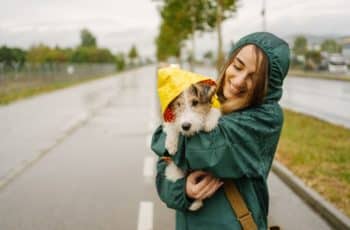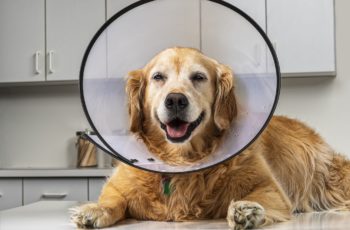You’ve likely been hearing that you should be providing “enrichment” for your dog. But if you’re just a little bit suspicious of all of the pricey things suddenly being marketed as dog enrichment toys and activities – congratulations! You’re onto something.
True dog enrichment is indeed critical, but you can’t just whip out your credit card and cross “enrichment” off of your to-do list. Even if your neighbor raves about a certain enrichment food puzzle or agility class, it may not provide any enrichment at all for your particular dog.
Here’s why: Canine enrichment is in the eye of the beholder, and not all dogs are the same. A little observation of your own furry friend will go a long way in helping you figure out great (and often free!) ways to provide effective enrichment.
What is Canine Enrichment? Enrichment = Meeting A Particular Dog’s Needs
Contrary to popular understanding, canine enrichment is not simply about providing something “extra.” It is also not about exercise or boredom-busting, although it will likely provide those things, too. It is about meeting your own particular dog’s needs by offering ways to engage in natural, species-typical behaviors – behaviors that our modern way of life often does not allow. Canine enrichment helps dogs be dogs – and solves many of our human problems along the way.
Is your dog digging in the yard? Chewing the furniture? Pulling on lead with his nose to the ground? Those behaviors can be the observational breadcrumbs that will lead you to effective enrichment . . . and a much happier dog.
Enrichment Started in Zoos
To wrap your mind around how to provide true enrichment, it helps to go back to the beginning. The concept of animal enrichment officially started in the 1970s, as zoos were starting to focus on conservation. Breeding was a newly important goal – and it was proving elusive. Some began to theorize that the reason animals weren’t procreating was because their daily life in captivity was too far from their norm in the wild. They weren’t behaviorally, emotionally, or physically healthy enough to breed.

Some zoos experimented with ways to close that gap – coming closer to meeting each animal’s natural needs. Out went the standard, bare-bones enclosures, and in flooded the perching areas, climbing vines, prey scents, hidden food, soundtracks of the wild, and more. The change brought dramatic success to breeding programs, but in addition to that it was an ah-ha moment. A new zoo focus was born: using behavior to assess health, and enrichment to improve it.
Unmet Needs Create Behavior Problems in Dogs
The pet dog world was paying attention. Like the non-breeding zoo animals, pet dogs were showing through their behavior – barking, chewing, anxiety and more – that something was off. Based on what was happening in zoos, behaviorists began to theorize that enrichment could make dogs more behaviorally sound, too. Rather than attempting to train the unwanted behavior out of the animal, they started looking at whether the dog’s needs were being met.
“When you don’t meet needs, you get maladaptive behaviors,” says Emily Strong, CDBC, SBA, who co-authored Canine Enrichment for the Real World with Allie Bender, CDBC, CPDT-KA, SBA. Both are experts in training and behavior, and their authoritative book combines a rich scientific foundation with years of client-tested ideas to improve dogs’ lives.
“What surprises people is that enrichment often solves behavior problems,” says Bender. “When they have an issue, people assume they need a trainer, but nobody learns well when their needs aren’t being met. So if the first step in a training plan focuses on meeting needs, sometimes the issues – jumping, barking, mouthing, digging or whatever – simply go away.”
Coming up with an enrichment plan for your dog starts with simple observation, and the Canine Enrichment authors encourage owners to “look with your eyes, not your ideas.” That means: watch your dog first; THEN come up with a specific plan for enrichment activities. Note what your dog tends to want to do, then experiment with objects, activities, or ways to rearrange the environment that might “scratch that itch.” Certain behaviors might suggest specific types of enrichment. (Bender and Strong offer offer a free, downloadable guide to developing an enrichment plan for your own dog on their website, PetHarmonyTraining.com)
Enrichment Ideas for Dogs Who Pull on Leash
If your dog is pulling on the leash with her nose to the ground, she could have an unmet need for scenting. You might want to experiment with the following enrichment activities:
- Adding more “sniffari” walks where you go at the dog’s pace, perhaps use a long lead, and deliberately seek out places that will be gloriously full of things to sniff: wildlife, other dogs, city life. (Some of the best options are free, like this one!)
- Signing up for one of the scent work classes that are popping up everywhere.
- Creating your own scent work adventures at home. (I saw a demonstration of this at a wolf sanctuary this summer, where they put a tiny bit of pickle juice in the grass and the wolves spent 15 minutes finding it, sniffing it, rolling in it…)
Obviously, you also want to work toward more pleasant leash walks by finding the right harness and working on engagement – but if an unmet need for scenting has been a factor in the pulling, those efforts will be more successful after this targeted enrichment.
Enrichment Ideas for Dogs Who Counter-Surf
If your dog is counter surfing, he could have an unmet need for foraging. You could experiment with these enrichment activities:
- Playing “find it” on walks, or while you’re watching TV!
- Using different food puzzles. Emphasis on “different” – because it doesn’t feel like foraging if it’s exactly the same each time! Get creative. Hide that stuffed Toppl under the couch, then in the bathroom…
- Using scatter feeding (both indoor and out) instead of bowls.
To address counter-surfing it is also important to stop leaving delicious things unsupervised on the counter! But for a dog who’s craving foraging, providing “legal” outlets can make him much less obnoxious around food in general.
Enrichment Ideas for Dogs Who Dig
If your dog is digging, there are different unmet needs it could signify: maybe she’s a terrier who needs to tunnel for rodents; maybe she’s a Beagle who needs to follow any scent to the game; maybe she’s a thick-coated Husky who’s just trying to reach cool dirt. You can experiment with the following enrichment activities:
- Provide a sandbox in a shady part of the yard, and hide toys in there.
- Make sure there’s a cool surface in a non-sunny nap spot like tile, a raised dog bed with breathable fabric, a crate bottom (some dogs hate it when you add cozy bedding!)
Dog Enrichment as an Interesting Puzzle
The final part of the experiment is assessment: is it really enrichment? You can only tell by watching your dog. Does he love it? Is he super engaged? Has it decreased the problem behavior that led you to try this? If the answers are yes, yes, and yes – that’s enrichment. But if he leaves that Kong half filled, or hides under your legs during that agility class, it’s not functioning as enrichment. Then it’s time to go back to the drawing board – or, if you look at it like the Canine Enrichment for the Real World authors, time to go back to your fun puzzle. Their background is in training, but at this point their hearts are in enrichment. “It’s way more fun to address these behavioral issues using enrichment rather than trying through training alone!” says Bender. “It’s a rewarding puzzle.”
“For me, thinking about enrichment flips the traditional mindset around dog behavior,” says Strong. “Instead of thinking ‘What do I want the dog to do?’, we think ‘What does this dog need to do?’ Oddly, when you do that, you often end up solving the first question.”


